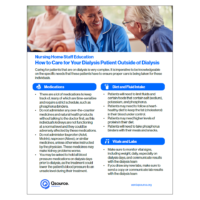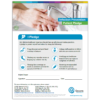
Nursing Home / Patient Safety
CMS recognizes dialysis in the nursing home setting as a home therapy option. Guidance released in August 2018 confirmed CMS’ recognition of dialysis in a nursing home setting (section 2271A, “Dialysis in Nursing Homes”), and states that Medicare-approved end-stage renal disease (ESRD) facilities can provide dialysis services to skilled nursing facility (SNF) residents in the nursing home with an approved home hemodialysis training and support modality.
Tools and Resources
Infection Control Pledges
Both the staff and patient Infection Control Pledges help to both educate and let staff and patients take control of doing their part in infection management.
Decreasing Hemodialysis Catheter Infections and Peritonitis
Preventing Peritonitis: Dialysis patients have a greater chance of getting an infection. Peritoneal dialysis (PD) uses a catheter to remove waste products from the blood. The catheter is placed in the lining of the belly, called the peritoneum. If harmful germs, like bacteria or fungi, get on the catheter, you may get peritonitis. Teaching your patients early prevention against peritonitis is key to decrease their risk for contracting an infection.
Your Infection Guide: This guide gives patients and staff the education they need to prevent infections. This guide will go through the facts and basic information on infections as well as how patients can contract an infection and guidance on how to protect themselves from contracting an infection.
Sample Infection Prevention and Control Quality Improvement Plans: The examples shown in the link below are for your reference. Proper quality improvement plans should be individualized to the situation, staff, and facility. These individualized plans can help staff implement strategies to decrease the rate of infections for your patients.
It only takes a minute to check your patient’s catheter before you connect. This staff resource is for staff to utilize to make sure they are properly assessing the patients access before each treatment. By checking the patient’s catheter prior to connection, you could prevent any adverse occurrences such as infections. Please use the link to access the printable catheter staff instructions.
Patient Catheter Check Guide: Teaching your patients to check their catheter could help prevent any adverse occurrences such as infections. Educate your patients so that they are familiar with any changes to their catheter or catheter site. Please use the link to access the printable Complete Patient Catheter Check Guide.
Staying Healthy on Peritoneal Dialysis: One of the most common problems with peritoneal dialysis (PD) is the risk of peritonitis. This is when your peritoneum, that natural lining in the stomach, gets infected. This might happen if germs get into the belly through the patients PD catheter. There are steps you can teach your patients to reduce the risk of your patients getting an infection. Visit the Dialysis Patient Citizens Center for more information on how to stay healthy on peritoneal dialysis.
Anemia Management
Educate Your Dialysis Patients About Anemia: This resource gives staff talking points to discuss anemia with their patients to educate them on what anemia is, what the signs and symptoms are, treatment options, risks and benefits associated with receiving a blood transfusion, and how to improve their outcomes to decrease the need for a blood transfusion.
Anemia in ESRD: Knowing what anemia is and how to prevent it is imperative for the care of someone with end-stage renal disease. Use this resource from the American Kidney Fund to educate your staff on what anemia is and why it’s important to monitor and treat in patients with end-stage renal disease.
Anemia and Kidney Disease: This webinar from the American Kidney Fund features Dr. Jay Wish, a nephrologist and anemia expert. He discusses why anemia happens in dialysis patients, the symptoms, and what you and your healthcare team can do to manage the condition.

 Download:
Download: Download:
Download:  Download:
Download:  Download:
Download:  Download:
Download:  Download:
Download:  Download:
Download:  Download:
Download:  Download:
Download: